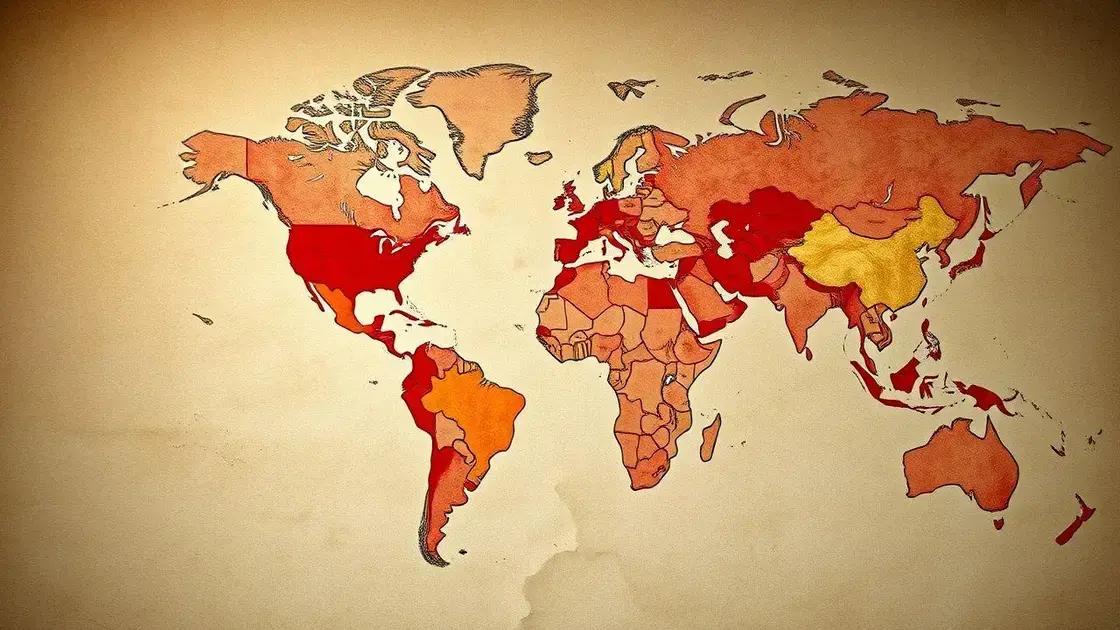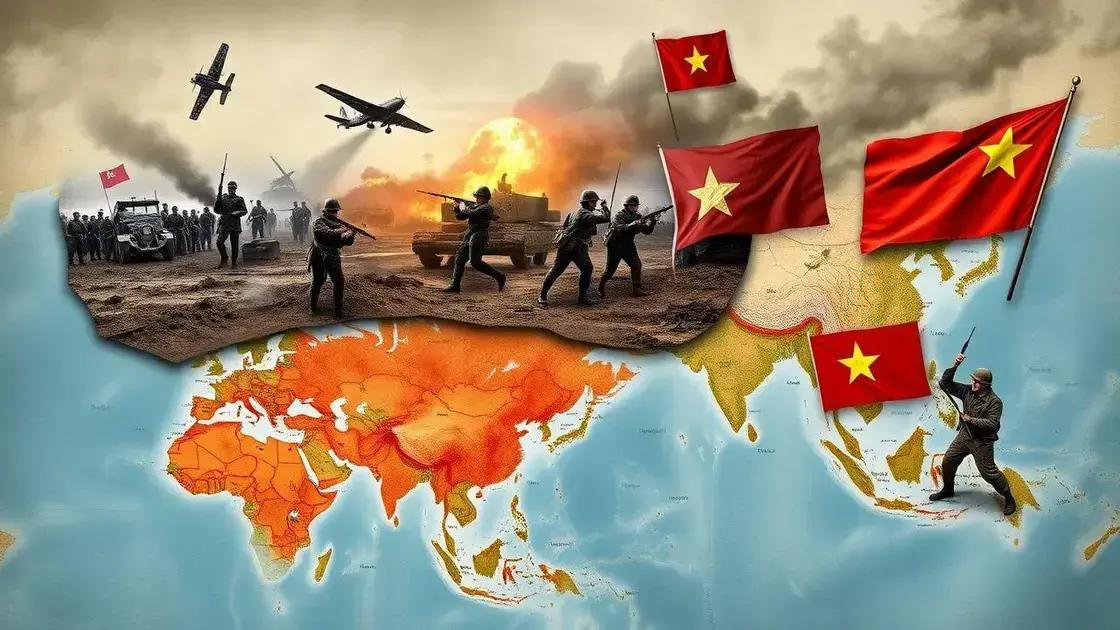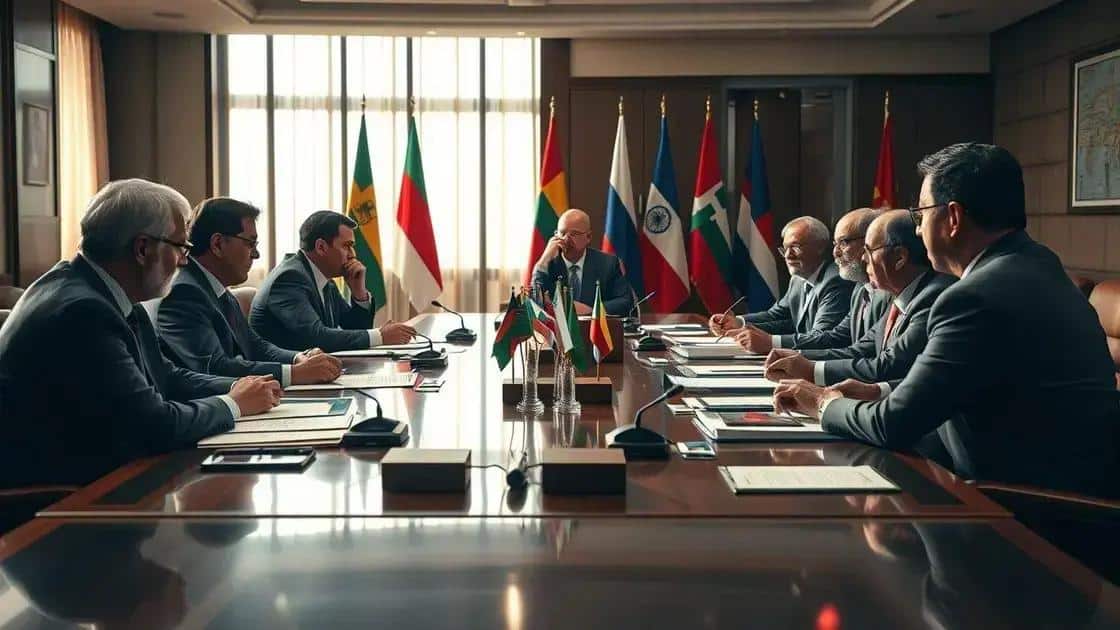International conflict: understanding its impact on peace

International conflict can be resolved through effective strategies such as diplomatic engagement, negotiation, mediation, and the involvement of international organizations, all aimed at fostering peace and stability.
International conflict can seem distant, yet it affects us all. Have you ever wondered how these conflicts shape the world we live in? In this article, we will explore their causes, consequences, and potential resolutions.
The roots of international conflict
Understanding the roots of international conflict is essential in addressing the issues that arise between nations. Various factors contribute to the tensions we see today. Historical grievances, political disputes, and economic inequalities all play significant roles in creating conflicts that span across borders.
Historical Grievances
Many conflicts have deep historical roots. These often stem from colonialism, territorial disputes, or past wars. When countries have unresolved issues from their histories, it can lead to ongoing tension. Highlighting historical context gives us a clearer view of current disputes.
Political Disputes
Political differences between nations can also fuel conflict. Disagreements about governance, ideology, and national interests can escalate quickly. For example, when one nation feels threatened by the policies of another, they may respond with hostility, leading to a cycle of retaliation.
- Disputes over leadership and control
- Rivalries between political ideologies
- Influence of external powers on local politics
Furthermore, unions or alliances can create tension for nations outside of these groups. A nation may feel isolated or attacked by a coalition, heightening their sense of vulnerability. This often results in alliances forming in response, perpetuating the conflict.
Economic Inequalities
Economic factors are also crucial in understanding the roots of international conflict. Issues such as resource distribution and trade imbalances can lead to resentment. Countries struggling economically may seek to assert their power through aggression, believing it is their way to gain respect and resources.
- Competition for valuable resources
- Disparities in wealth among nations
- Impact of sanctions on national economies
Recognizing these underlying issues is the first step in resolving long-standing conflicts. It is vital for nations to engage in dialogue, addressing these historical grievances, political disputes, and economic inequalities. Through understanding the roots of these conflicts, we can work towards lasting peace.
Major historical examples of international conflict

Throughout history, there have been significant major historical examples of international conflict that have shaped nations and cultures. These conflicts not only defined borders but also altered the course of history. By examining these examples, we can understand the patterns of human behavior in resolving disputes.
World War I
World War I was a major turning point in international relations. Triggered by complex alliances and rivalries, it involved countries around the globe. Nationalism played a key role, as many nations sought to assert their dominance and independence. The aftermath of the war led to changes that still influence us today.
World War II
World War II further illustrates the consequences of unresolved conflicts. It was caused by the failures of the Treaty of Versailles and the rise of totalitarian regimes. This war resulted in massive global devastation and the formation of the United Nations, aiming to prevent future wars by fostering dialogue.
- Impact of the Great Depression
- Expansionist policies of Axis powers
- Formation of powerful alliances
Another significant conflict is the Cold War, which was marked not by direct combat but by political tension and nuclear arms races. The ideological battle between capitalism and communism dominated global politics for decades. This period also showcased how diplomacy and espionage evolved in response to threats.
The Vietnam War
The Vietnam War serves as another important example of international conflict. It was not only a struggle between North and South Vietnam but also involved major powers like the United States and China. The war highlighted the complexities of foreign intervention, as it raised questions about the morality of war and the impact on civilian populations.
- The role of guerilla warfare
- Public opposition in the U.S.
- Consequences on Vietnamese society
By analyzing these major historical examples, we gain insights into the causes and effects of conflict. Understanding past events allows us to better address current international disputes and work toward peaceful solutions.
Impact of international conflict on global peace efforts
The impact of international conflict on global peace efforts is profound and multi-faceted. Conflicts create immediate challenges for nations and international organizations striving to maintain peace. As tensions rise, the focus on dialogue often diminishes, leading to further escalation instead of resolution.
Diplomatic Strains
International conflicts strain diplomatic relations. When one nation engages in aggressive behavior, it creates distrust among others. This can hinder peace-building efforts and make it difficult for countries to come together on common ground. As diplomatic channels shrink, the chances for peaceful negotiations are reduced.
Resource Allocation
In times of conflict, governments often redirect resources toward military spending instead of social programs or diplomacy. This shift can lead to increased poverty and instability, making peace harder to achieve. Citizens in conflict zones may face dire consequences as resources are depleted.
- Increased military budgets
- Decreased funding for peace initiatives
- Social unrest in affected countries
Moreover, ongoing conflicts can complicate relations. Countries may be unwilling to engage in cooperative agreements if they feel threatened by neighboring nations. Historically, this has led to arms races where nations prioritize security over peace.
Humanitarian Issues
International conflict often results in humanitarian crises that further undermine peace efforts. Displaced populations create additional burdens on neighboring countries. This influx can lead to tensions, as resources become scarce and host countries struggle to provide services.
- Refugee crises and their effects
- Pressure on local economies
- Human rights violations in conflict zones
Furthermore, these crises garner global attention and resources, but they often fail to address the root causes of conflict. As a result, while immediate humanitarian needs are met, long-term peace solutions are neglected. By understanding these implications, nations can better navigate the complex dynamics of international conflict and work toward sustainable peace.
Strategies for resolving international conflicts

There are various strategies for resolving international conflicts that nations can utilize to promote peace and stability. These strategies encompass diplomacy, negotiation, and mediation, aiming to address the root causes of tensions. Understanding how to implement these methods can help prevent further escalation of conflicts.
Diplomatic Engagement
Diplomatic engagement serves as a cornerstone in resolving international disputes. Countries often engage in dialogue to discuss their differences and seek common ground. This practice helps to build trust and understanding. Through diplomatic channels, nations can express their concerns and work towards solutions without resorting to conflict.
Negotiation and Compromise
Negotiation is another critical strategy. In negotiations, parties involved present their demands and work to reach an agreement. Successful negotiations often require compromises from both sides. It is essential for all parties to remain flexible and open-minded to find a solution that respects each nation’s interests.
- Identifying common interests
- Creating win-win scenarios
- Establishing timelines for agreements
Furthermore, employing a third-party mediator can be beneficial. Mediation involves an unbiased individual or organization facilitating discussions. This approach can help de-escalate tensions and ensure both parties feel heard.
International Organizations
International organizations play a vital role in conflict resolution as well. Bodies like the United Nations offer platforms for dialogue and negotiation. They can also provide peacekeeping forces to monitor ceasefires. This support encourages nations to adhere to agreements and work towards sustainable peace.
- Monitoring compliance with agreements
- Providing humanitarian assistance
- Encouraging collaboration among nations
By employing these strategies—diplomatic engagement, negotiation, and the support of international organizations—nations can work toward resolving conflicts. Taking proactive steps not only addresses current disputes but also helps build a stronger foundation for lasting peace in the future.
FAQ – Frequently Asked Questions about International Conflict Resolution
What are the most effective strategies for resolving international conflicts?
The most effective strategies include diplomatic engagement, negotiation, mediation, and active participation in international organizations.
How can countries ensure successful negotiations?
Countries can ensure successful negotiations by identifying common interests, remaining flexible, and seeking win-win solutions.
What role do international organizations play in conflict resolution?
International organizations, like the United Nations, provide platforms for discussion, support peacekeeping efforts, and promote cooperation between nations.
Why is understanding the roots of international conflict important?
Understanding the roots helps nations to address the underlying issues and create sustainable solutions, which ultimately fosters long-lasting peace.






